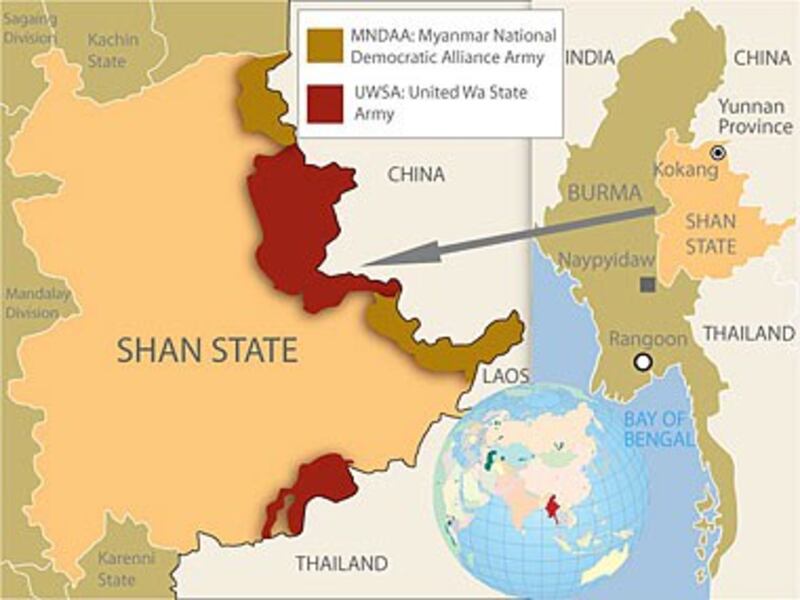RANGOON—Burma’s secretive ruling junta has withdrawn around 100 government employees from the ethnic-Chinese Wa region of Kokang, near the Chinese border, prompting fears of renewed military tension, authoritative sources in the region said.
An unusual government directive told civil servants—including education, health, and agriculture ministry employees—to take three months’ holiday and leave the Wa region, according to a knowledgeable witness.
The statement stipulated that Education Ministry staff would take their holidays with full pay but didn’t mention whether employees of other ministries would be paid, the source said.

“Two regional [Wa army] commanders told me by phone that government employees will be given a long leave, and they will be recalled. Schools will be closed,” a United Wa State Army (UWSA) official said in an interview.
"One teacher said they were told to leave within 2 weeks. A lot of them left Panhseng on [March] 23 and today on the 25th some left Maingmaw," he said.
“I think it’s psychological warfare, so people including businessmen will be afraid to come to the region. I haven’t seen any signs of an actual military movement to attack, but we are always ready and prepared.”
The official, who asked not to be named, said the junta hadn’t yet addressed some Wa concerns.
“We will never give up our arms,” he said.
A businessman living in the border area said local people expect fighting soon, with children and the elderly already crossing the border as refugees into neighboring China.
“[They are] thinking there’s going to be a battle soon,” the businessman said.
“Some don’t have enough money to go and live in China,” he said. “About 300 of them have left.”
The self-governing ethnic minority known as the Wa live mainly in Burma, where they have their own army, the powerful USWA.
A military analyst living in Kokang said the moves seem closer to Burmese intimidation tactics than an immediate threat of military action by government troops, which last attacked the Wa region in August 2009.
“I’m sure they don’t dare actually attack the Wa,” he said.
2009 fighting
Thousands of refugees were displaced by the last military engagement between government and Wa troops, with 39 villages attacked and hundreds of houses burned down, rights groups said.
The fighting erupted in August 2009 between government troops and members of a militia known as the Myanmar National Democratic Alliance Army (NDAA), breaking a ceasefire the government and the militia signed more than 20 years ago.
The ostensible spark for the clashes was a move against a gun-repair factory the government believed was being used as a front for narcotics manufacturing, but fighting escalated, with Burmese troops taking control of Laogai, the Kokang capital.
The Kokang fighting drew in other groups including the UWSA, which with some 20,000 fighters is the largest ethnic army, but a ceasefire between the UWSA and the government appears to have held since then.
Now, residents are saying that a Soviet-made MiG fighter plane belonging to the government overflew Kokang on March 23, sparking concerns of fresh fighting in the border region.
However, the Kokang-based military analyst didn’t think this signified an imminent attack.
“If they wanted to, why would they show off by openly flying their MiG fighter planes in lieu of a surprise attack?” he said.
Sources in the region said that the government recently imported military trucks from China through the border towns of Ruili and Kyeguang.
Military cars
One Kokang resident said the government was importing “cars covered with military green and … covered with army camouflage.”
“I don’t know what they are carrying, and some of the cars are wholly covered. These cars are coming in daily—it’s been more than a week,” the resident said.
“The cars are temporarily kept in Kyegaung car compound, and from there they are driven to Muse...and from there gradually to Mandalay,” a source close to the military confirmed.
Muse is a town in Burma’s Shan state, one of the regions where the Wa are concentrated.
Rights groups have said the Burmese army deployed battalions to clear civilians from large areas of central Shan state over a period of several days last year, in an intensified campaign against an insurgent group called Shan State Army-South.
Some 40 percent of Burma’s 56 million people belong to an ethnic minority, with most concentrated in the highlands that abut the country’s borders.
Original reporting by RFA’s Burmese service. Burmese service director: Nancy Shwe. Translated from the Burmese by Nancy Shwe. Executive producer: Susan Lavery. Written in English by Luisetta Mudie and Sarah Jackson-Han.
